Captain W. Evans, a player of moderate skills, introduced a gambit in 1824 where White sacrificed a pawn to get a strong center. This gambit obviously came to be known as Evans Gambit! In 1838, he played his gambit against Alexander MacDonnell, the greatest English player of his time, and managed to win the game and the gambit drew a lot of public attention. Subsequently, players of much greater standing like Morphy, Anderssen and Chigorin created gems with this gambit.
But with the progress in the theory of the game, this gambit went out of vogue and appears rarely in modern games as defenders are now well aware of the variations and how to handle those.
The opening moves go something like this:
| 1. | e4 | e5 | ||
| 2. | Nf3 | Nc6 | ||
| 3. | Bc4 | Bc5 | ||
| 4. | b4 | This offer of QNP constitute the gambit. White follows it up by c3 and d4 |
Our idea of telling all these is not to sell you Evans Gambit but only to create a background! You can take it as one of the many interesting stories behind chess games that make chess and chess history so fascinating! But what we intend to show is that given any set up, brilliant ideas are not the prerogatives of chess masters. Even amateurs like you can have a flight of imagination to produce little gems like the following one, incidentally produced with Evans Gambit in a game played in 1862 between two amateur players (White was 16 year old)!
| 1. | e4 | e5 | ||
| 2. | Nf3 | Nc6 | ||
| 3. | Bc4 | Bc5 | ||
| 4. | b4 | Bxb4 | ||
| 5. | c3 | Bc5 | ||
| 6. | d4 | exd4 | ||
| 7. | cxd4 | Bb6 | ||
| 8. | 0-0 | d6 | ||
| 9. | Nc3 | Bd7 | 9. … Na5 or 9. … Bg4 is better | |
| 10. | e5 | dxe5 | ||
| 11. | Re1 | Nge7 | ||
| 12. | Ng5 | Be6 | 12. … 0-0 would be disastrous after 13. Qh5 | |
| 13. | Bxe6 | fxe6 | ||
| 14. | Nxe6 | Qd6 | ||
| 15. | Nxg7+ | Kf8 | ||
| 16. | Qg4 | Bxd4 | ||
| 17. | Ne4 | Qb4 | Attacking the other White Rook and threat of checkmate may look good but 17. … Qg6 was needed for defense | |
| 18. | Ne6+ | Ke8 | Most players would play 18. Bd2 to neutralize Black’s threats, but White saw better possibilities in this position | |
| 19. | Nf6+ | Kf7 | ||
| 20. | Ng5+ | Kf8 | These were the possibilities: 20. … Kxf6 21. Qe6+ Kg7 22. Qf7+ Kh6 23. Ne4+ with mate to follow 20. … Kg6 21. Qh5+ Kf5 22. g4+ Kxf6 23. Qf7# 20. … Kg7 21. Nh5+ Kf8 22. Qf3+ Ke8 23. Nf6+ Kd8 (if 23. … Kc8 24. Nd5+ wins Black’s Q) 24. Nf7+ Kc8 25. Qh3+ Kb8 26. Nd7+ Kc8 27. Nb6+ Kb8 28. Qc8+ Rxc8 29. Nd7# |
Position after move 20

| 21. | Ba3 | Qxa3 | White moved QB to clear the mating threat. If Black tries 21. … Qc4 to prevent Qe6 by White, then 22. Rc1 drives away the Q and makes Qe6 possible | |
| 22. | Qe6 | Nd8 | 22. … Kg7 23. Nh5+ Kf8 24. Qf7# | |
| 23. | Qf7+ | Nxf7 | ||
| 24. | Ne6# |
You have to go a long, long way to see a more beautiful checkmate! Do you have any hesitation in calling this a masterpiece though produced as ‘amateurpiece’!?
This game gives an excellent example of tactical play using a Knight pair!
If you needed some convincing to follow our advice for raising your game, in particular the necessity to keep records, this game should be an incentive for you to do that! You never know when a future chess historian will discover a gold nugget in the archives of the games you played!


Trackbacks/Pingbacks